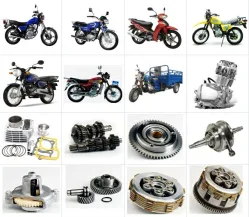What are the parts of a motorcycle engine called?
2023-10-21
A motorcycle engine is a complex assembly of many components, each with its specific function. Here are the main parts of a motorcycle engine:
1. Cylinder: The cylinder is a cylindrical chamber where the combustion of fuel and air takes place. Most motorcycle engines have either a single cylinder, multiple cylinders, or in-line cylinders, depending on the design.
2. Piston: Pistons are cylindrical components that move up and down inside the cylinder. They are connected to the crankshaft and play a crucial role in compressing the fuel-air mixture, igniting it, and converting the energy into rotational motion.
3. Crankshaft: The crankshaft is a rotating shaft connected to the pistons. It converts the reciprocating motion of the pistons into rotational motion, which drives the motorcycle's wheels.
4. Connecting Rods: Connecting rods connect the pistons to the crankshaft, transferring the linear motion of the pistons into rotary motion.
5. Cylinder Head: The cylinder head is located at the top of the cylinder and houses the intake and exhaust valves, spark plug, and often the camshaft. It forms the combustion chamber and helps control the flow of air and fuel in and out of the cylinder.
6. Valves: Motorcycle engines typically have two types of valves: intake valves and exhaust valves. These valves open and close to control the flow of air (intake) and exhaust gases (exhaust) in and out of the cylinder.
7. Camshaft: The camshaft is a rotating shaft with specially shaped lobes that control the opening and closing of the valves. It is usually driven by a timing chain or timing belt and is synchronized with the crankshaft.
8. Timing Chain/Belt: A timing chain or timing belt synchronizes the motion of the crankshaft and camshaft, ensuring that the valves open and close at the correct times in relation to the piston's position.
9. Cylinder Block: The cylinder block or engine block houses the cylinders and provides support for various engine components. It also contains the engine's coolant passages for temperature regulation.
10. Piston Rings: Piston rings are fitted around the pistons to create a seal between the piston and the cylinder wall. They prevent the escape of combustion gases and control oil consumption.
11. Spark Plug: The spark plug is an essential component that generates a spark to ignite the air-fuel mixture in the cylinder, initiating combustion.
12. Intake Manifold: The intake manifold is a system of tubes or passages that deliver the air-fuel mixture from the carburetor or fuel injection system to the intake valves.
13. Exhaust System: The exhaust system consists of pipes, headers, and a muffler that expels exhaust gases from the engine and helps reduce noise.
14. Carburetor or Fuel Injection System: These components deliver the right mixture of air and fuel to the engine. Carburetors are common in older motorcycles, while modern ones typically use fuel injection systems.
15. Cooling System: Some motorcycles have liquid-cooled engines with a radiator, water pump, and coolant to regulate engine temperature. Others use air cooling, relying on airflow over the engine to dissipate heat.
16. Oil System: The oil system includes an oil pump, oil filter, and oil passages that lubricate engine components, reducing friction and wear.
These are the fundamental parts of a motorcycle engine. The exact components and their arrangement can vary depending on the specific engine design and manufacturer. Motorcycle engines come in various configurations, such as single-cylinder, twin-cylinder, inline-four, V-twin, and more, each with its unique characteristics.



